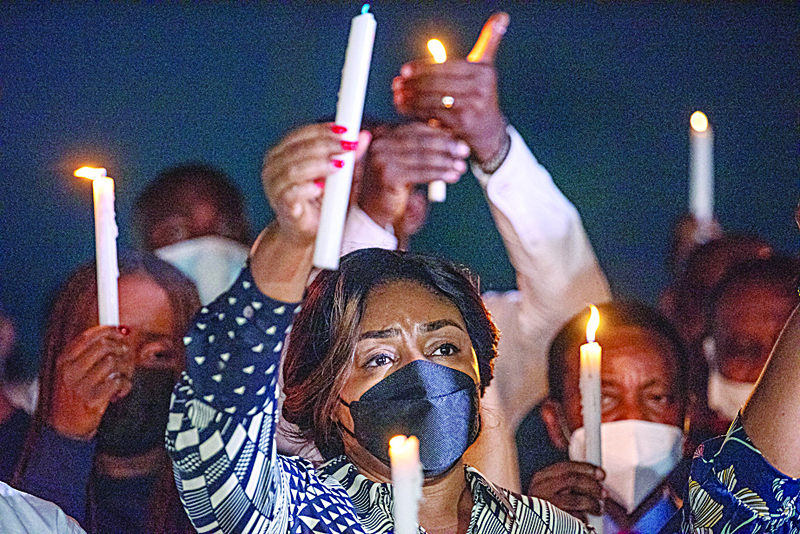 KINSHASA: First Lady of the Democratic Republic of Congo, Denise Nyakeru Tshisekedi, (C) holds a candle while attending a vigil in Kinshasa, in solidarity with the people of Goma affected by the eruption of the Nyiragongo volcano located in the Virunga National Park, on May 22, 2021. - AFP
KINSHASA: First Lady of the Democratic Republic of Congo, Denise Nyakeru Tshisekedi, (C) holds a candle while attending a vigil in Kinshasa, in solidarity with the people of Goma affected by the eruption of the Nyiragongo volcano located in the Virunga National Park, on May 22, 2021. - AFP
GOMA: Streets in the eastern DR Congo city of Goma returned to life yesterday, five days after residents fled following warnings that the nearby Nyiragongo volcano could erupt again. Even as emergency officials insisted it was still not safe to return, streets in the city centre were clogged with traffic, the flow of pedestrians seemed close to normal and some shops had reopened.
In front of the city's main hospital, traffic navigated around large cracks that had emerged after the volcano first erupted last month, an AFP journalist saw. Nyiragongo suddenly erupted on May 22, spewing out two rivers of lava before stopping the following day. But powerful aftershocks ensued, causing several buildings to collapse and triggering panic among the population.
Scientists fear a possibly catastrophic eruption under the floor of nearby Lake Kivu. In their worst projection, a "limnic eruption" would heat carbon dioxide dissolved in the depths of the lake, sending the gas to the surface. Forming a vast, invisible cloud, the gas could settle at ground level on the lakeshore city, asphyxiating its inhabitants, according to this scenario. In response, the North Kivu provincial authorities last Thursday ordered the evacuation of most of the city's districts. Around 400,000 people, out of a population of 600,000, were uprooted.
Around 120,000 arrived in the town of Sake, about 25 kilometres (15 miles) away to the west, while thousands more fled to the Rwandan town of Gisenyi, just across the border to the east. According to the UN's refugee agency, the UNHCR, 350,000 evacuees are in need of emergency help. Many have found refuge in schools, churches and host families. Access to potable water is the major problem. The UN's World Food Programme (WFP) is distributing food in Sake and Rutshuru, as well as in Minova, in the neighbouring province of South Kivu.
'Danger is full-time'
People have begun trickling back to Goma, the North Kivu capital, in the absence of large tremors, even though the volcano's monitors insist it is not safe to return. According to an official with the Congolese Directorate for Migration (DGM), 705 displaced people returned from Rwanda on Friday, 729 on Saturday and 111 on Monday morning.
One of those who had left was Francoise Habimana, who fled to the Rwandan capital of Kigali with her children, where they stayed with a host family. Yesterday, she was among dozens of families queueing at the border crossing to return home. Another was Beatrice Wakandwa. "It was a bit hard to be on my own in Rwanda, even though the people were hospitable," she said.
"I don't have a choice. Whatever happens, I prefer to be back in Goma with my family." However, a crisis management cell set up by the North Kivu authorities said Tuesday that alert status "is still red," meaning that people were advised not to return home. "Today, the scientific data have recorded 71 earth tremors, the majority of which have not been felt by the population," the emergency body said.
Despite a "comparatively small fall in seismicity, the danger is full-time," it added. "We therefore recommend that people stay vigilant, listen to the news and strictly observe the measures set down by the provincial authorities." Rwanda said late Monday that there was no "imminent risk" of a limnic eruption. - AFP

